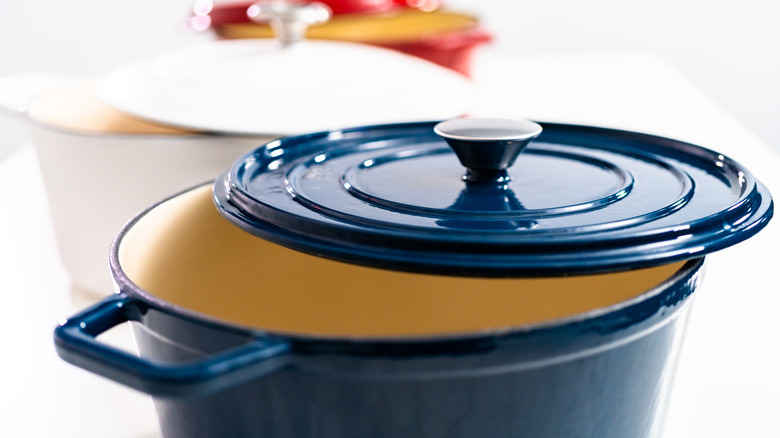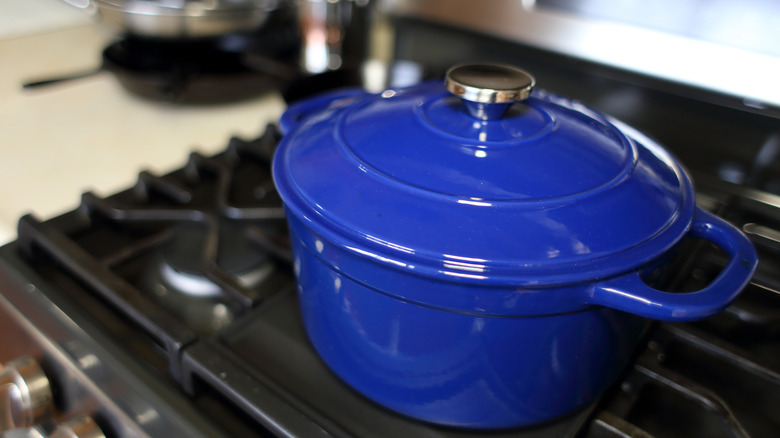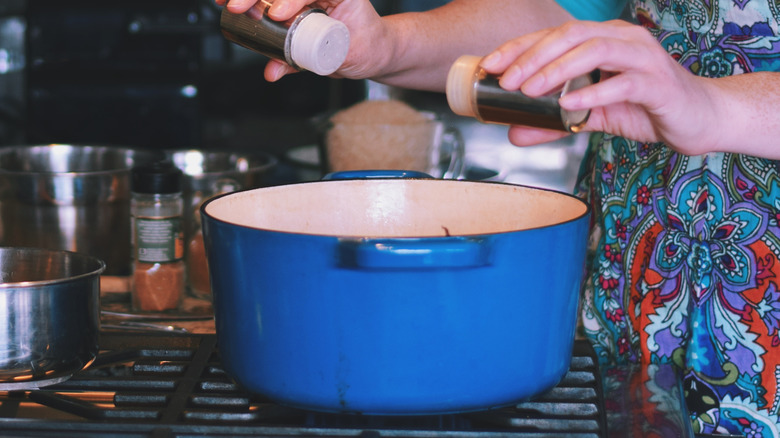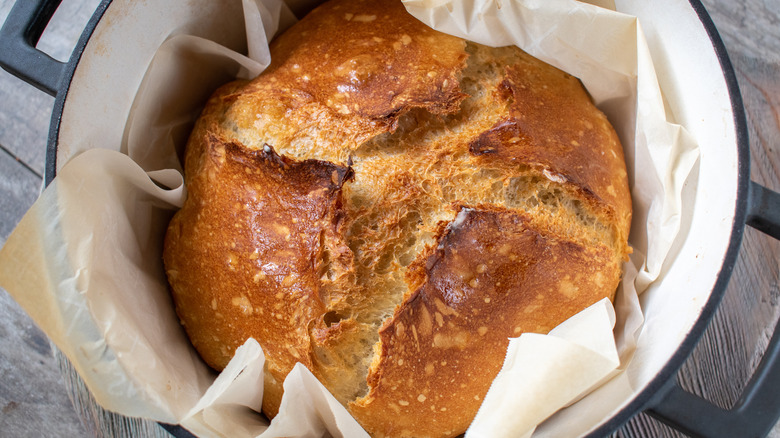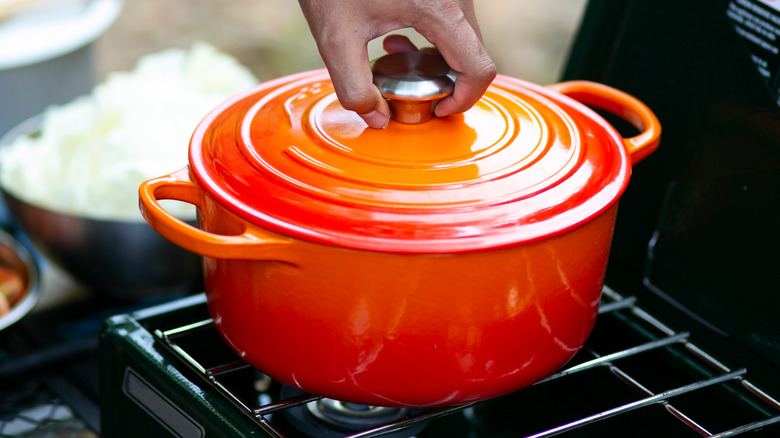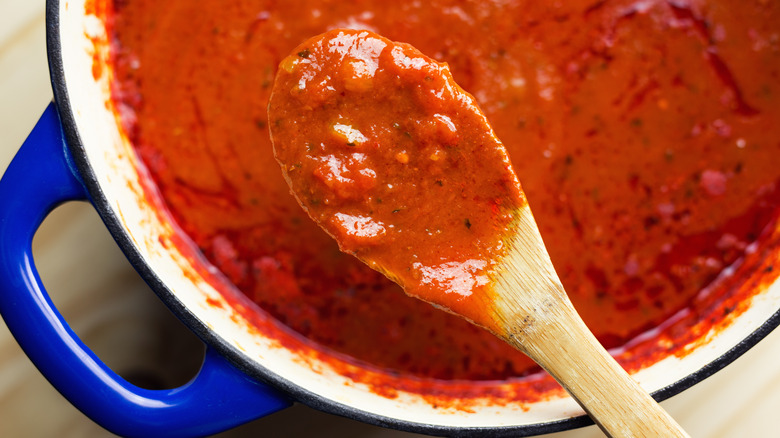So You Got A Dutch Oven. Now What?
No kitchen worth its weight in cookware should be without a Dutch oven. This heavy-duty, hard-working pot can go from stovetop to oven, and from oven to tabletop without missing a beat. While it doesn't cook on its own power, this cookware could legitimately be compared to an Instant Pot thanks to its workhorse nature and its sheer versatility.
As its name suggests, the cookware first came to be thanks to manufacturers in the Netherlands, whose skilled artisans made pots out of copper and brass (via Wasserstrom). Today's Dutch ovens are the result of experiments carried out by an Englishman named Abraham Darby, who thought to use cast-iron to make his cookware, making his cheaper and more durable than their high-end brass and copper cousins.
You might be tempted to dismiss this cookware as nothing more than a pricey, glammed-up ceramic pot — particularly if you're looking at the range of brightly colored varieties most cooks would kill to own. As all self-respecting Dutch ovens will show, this covered pot isn't just a pretty face; its well-fitting lid makes it an indispensable, all-around workhorse of a kitchen item to cook with.
How to pick a Dutch oven
While French cookware company Le Creuset became synonymous with this type of pot, you don't need to part with a few hundred dollars to get the Dutch oven of your dreams. These items can be had for anywhere between $50 to $300 dollars, and The Kitchn suggests choosing the best version you can afford because this is an investment purchase that could last you years.
Before you buy this special type of cookware, do your homework. Go online and look for the best pot for your budget. When you've found the pot, go somewhere where you can physically handle it. It should be heavy, with reinforced walls and a thick bottom. Cook's Illustrated warns that because the style of cast iron cookware is built for lengthy cooking times, having a lighter, thinner model can result in burnt food.
Examine your prospective pot's handles, making sure you can hang on to it even if you're wearing oven gloves. The Kitchn even recommends getting a larger Dutch oven, so you can comfortably fit enough food to feed a crowd.
How to season a Dutch oven
If your Dutch oven has an enamel coating, it's ready to start cooking. If your pot lacks one, you'll want to season it in order to prevent rust and to give it a non-stick sheen (via Taste of Home).
To do this, clean your new cookware with dishwashing soap and water, then dry and coat the clean surface with vegetable oil. Lay the oiled cookware upside down on a prepared cookie sheet layered with aluminum foil and bake for an hour on the top rack of your oven at 400 degrees Fahrenheit and make sure to keep your windows open when this is being done.
The same procedure may be used to reseason an older Dutch oven that has built-up rust. You'll just want to make sure that you strip off the oxidation and clean the cooking surface properly before you begin the reseasoning process.
Ways to cook with your Dutch oven
Cooks and chefs who have owned a Dutch oven for years will swear by its versatility — so much so that it's not about what this item can do, but what it can't.
A well-made Dutch oven can hold heat well, which makes it the perfect pot to brown meat and vegetables with. Its ability to maintain heat levels and disperse the warmth around makes it great to braise meat in since it can both sear at high heat and then simmer at low temperatures. The item can also be used to make soups, and cook both pasta and pasta sauces, although not at the same time unless the recipe calls for it, per Bon Appétit. The cookware can even be used to make bread, although the Michelin Guide warns not to expect success on the first attempt since a number of good bread recipes weren't written with a Dutch oven in mind.
Due to the way the pot is colored and designed, this item can go from stovetop or oven to table looking like the kitchen royalty that it is — regal and ready for service.
You can get creative with your Dutch oven
As if braising, frying, boiling, sauteing, and baking weren't enough, the Dutch oven has a few hacks under its cover too. America's Test Kitchen says the cover of the oven can double as a roasting pan when you're baking with it — just flip it over and line it with foil to turn the lid into the perfect vessel for roasting potatoes. If you're cooking on the stovetop, you can use the same lid to hold semi-cooked food before throwing it back into the pot.
If your Dutch oven can keep things hot, America's Test Kitchen says it can keep things cool as well. You can use the item as a salad serving dish by filling the bottom with ice water and leave it be for about five minutes before discarding the water, wiping it down, and then filling the pot with the salad greens of your choice.
How to clean your Dutch oven
You might not have thought this far ahead when you decided to take the leap and invest in your Dutch oven, but if you take good care of it, you'll find — as most previous owners have — that it lasts a long, long time. Long enough, as the Michelin Guide points out, to go from one generation to another.
The lifespan of this cookware depends entirely on how you care for it, and a great part of this care involves making sure you treat its enamel interior well. The venerable dining guide recommends that you wait for your cookware to cool before washing it since its enamel lining has been known to crack if it is subjected to extreme temperatures. Always wash this type of pot by hand — no matter what the care instructions say — since the interior coat doesn't last forever and a rough soap can actually hurt it. If you need to soak the sturdy pot, make sure the liquid doesn't get up to the top since the enamel coat doesn't go all the way up to the top, and water could lead to rust. Additionally, keep an eye out for burnt bits of food, which can stain the bottom of your pot. If you take care of your Dutch oven, you will have a piece of cookware that can last for generations.
